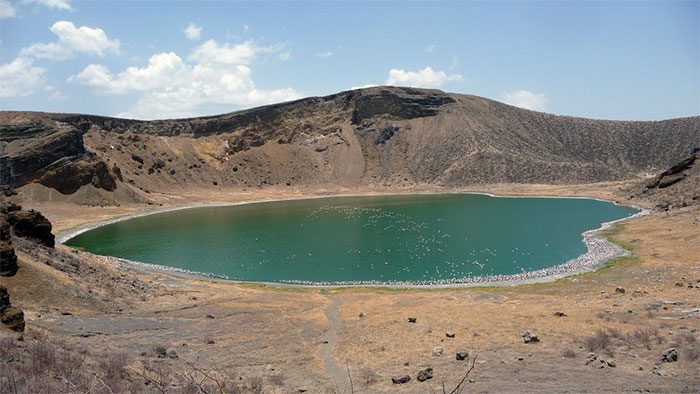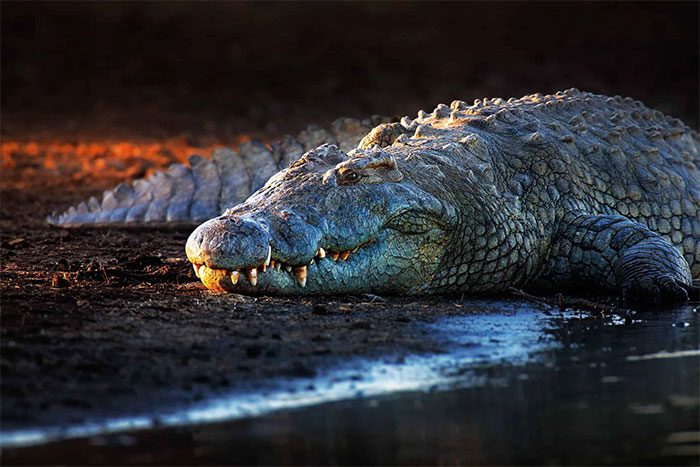Crocodiles are among the most ferocious predators on Earth, and their ancestors, the Deinosaurs, could even compete with large carnivorous dinosaurs and Titanoboa. To this day, any water system that houses crocodiles remains a forbidden zone where many creatures dare not venture.
In the vast continent of Africa, there exists a large and formidable species of crocodile: The Nile Crocodile. But what would it be like if 12,000 Nile crocodiles lived in one place? We will find the answer when we visit Lake Turkana.

The Nile Crocodile (Scientific name: Crocodylus niloticus) is the largest crocodile species in Africa and is notoriously known as a man-eater. As such, they are both feared and revered in the cultural beliefs of the Egyptians.
Kenya, in Africa, is a “paradise” for many wildlife species, with dense vegetation and lush forests housing thousands of animal species. However, northern Kenya is entirely different; it is a barren land, also known as the “nightmare” for many wild animals.
Anyone who sets foot here will be astonished by the landscape before them, a seemingly endless desert with almost no life that can survive in the hot, waterless sands. Yet, in this desert, there lies a lush green lake hidden among the dunes, an eggplant-shaped body of water that is home to the crocodiles: Lake Turkana.

Lake Turkana is located in the Great Rift Valley, Kenya. It is the largest desert lake in the world. The surrounding areas are primarily volcanic. Turkana National Park was designated a UNESCO World Heritage site in 1997 and expanded in 2001. The entire area of Turkana National Park is also a habitat and stopover for hundreds of bird species and countless animals, making it particularly important as a home for the rare Nile crocodile.
This is the largest lake in Kenya and the largest alkaline lake in the world. Despite being surrounded by desert, Lake Turkana resembles a sparkling emerald set upon the sand.
The total area of Lake Turkana is approximately 6,500 square kilometers, with a significant quantity of non-toxic blue-green algae present. It is this abundance of algae that gives Lake Turkana its vibrant blue color.

Currently, although not endangered, the Nile crocodile population in many countries remains vulnerable due to a significant decrease in numbers. Statistics show that Nile crocodiles can grow up to 5 meters long, with adults weighing around 225 kg, although some individuals have been recorded at weights up to 700 kg.
Not only impressive in beauty, color, and size, but Lake Turkana also possesses sediment layers with thousands of years-old fossil samples. Geologists believe that the volcanic activity in the area has contributed to the unique geology of the lakebed and its surroundings.
However, do not be deceived by its beautiful appearance; numerous dangers lurk behind this beauty, as a large number of Nile crocodiles are hidden in the lake or on its shores, basking in the sun or quietly waiting for prey to approach the water’s edge.
The Nile crocodile is the largest crocodile species in Africa, primarily found in the Nile River basin. This is an incredibly aggressive species; while many wild animals fear hippos, lions, elephants, or African buffaloes, this crocodile shows no concern for their presence. Additionally, the Nile crocodile is known for frequently attacking humans and boats.

In addition to its enormous size, regarded as the largest freshwater predator in the world, the Nile crocodile also instills fear in humans due to its sharp teeth and terrifying bite force. Any prey that comes within their sights has little chance of escaping death, and humans are no exception.
As the sun rises, groups of crocodiles will haul themselves onto the shores to sunbathe. Sometimes they will lie motionless on the banks with their mouths wide open. The crocodile population in Lake Turkana is substantial, approximately 12,000 individuals. While the name Nile crocodile implies that they must live in the Nile River, one might wonder why such a large population resides in Lake Turkana, surrounded by deserts.
Scientists have discovered that Lake Turkana was formed over 30 million years ago. The ancestors of humans, Australopithecus, also once lived by Lake Turkana, choosing to leave Africa and migrate to other places except Antarctica around 50,000 years ago.
Through research, scientists found that ancient Lake Turkana and the Nile River were connected; Lake Turkana is situated upstream from the Nile River, and Nile crocodiles that lived in the Nile swam upstream to reach Turkana.

Nile crocodiles that lived in the Nile swam upstream to reach Turkana.
Not long after, the local climate changed, sand and desert began to form, isolating Lake Turkana from the Nile River, resulting in a significant population of Nile crocodiles being separated along with the lake.
Despite being surrounded by a barren desert, the scenery within the lake is vibrant, with various fish species such as tiger fish, catfish, and perch… notably, some fish can exceed two meters in length and weigh several hundred kilograms—these fish provide a rich food source for the Nile crocodile.




















































